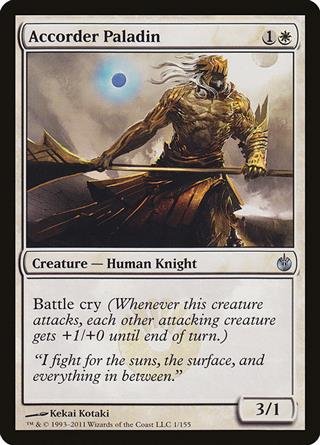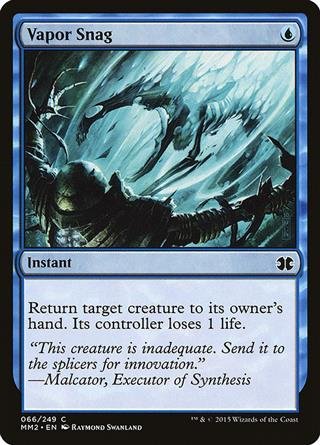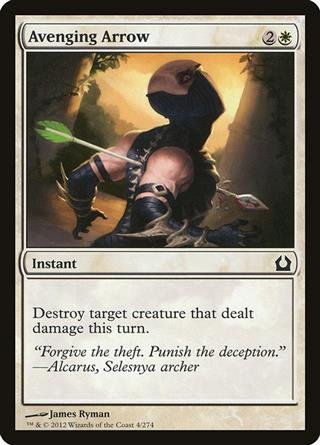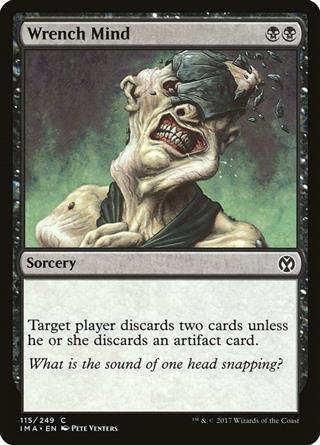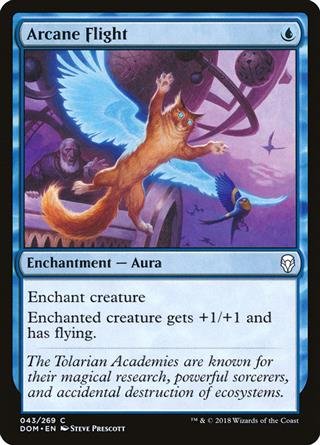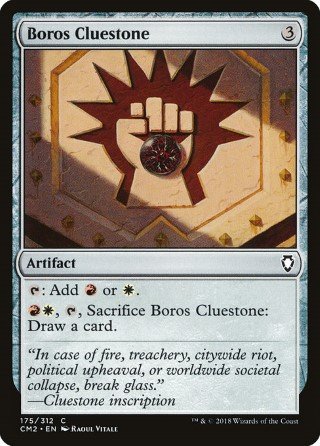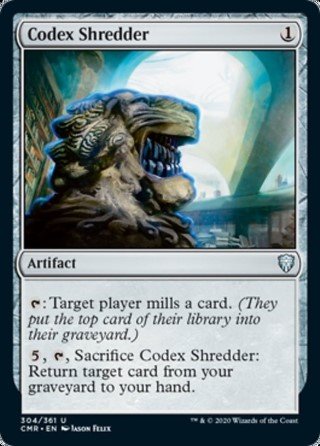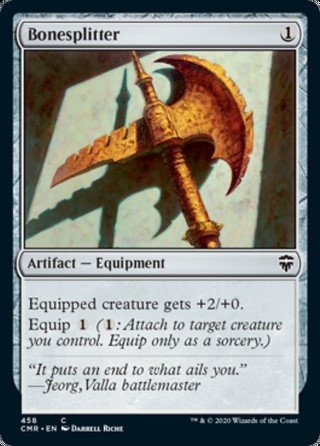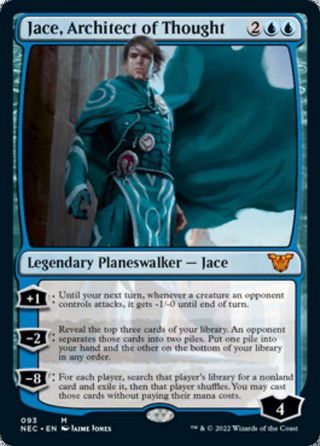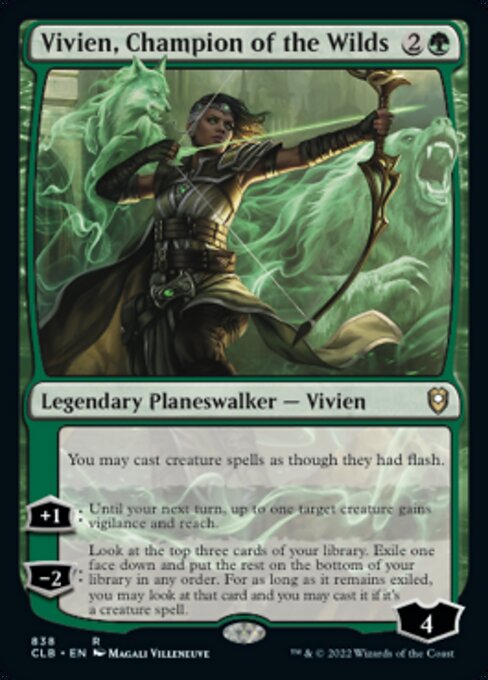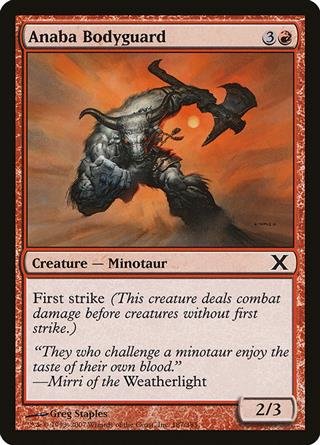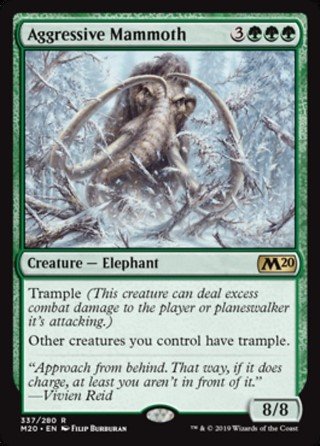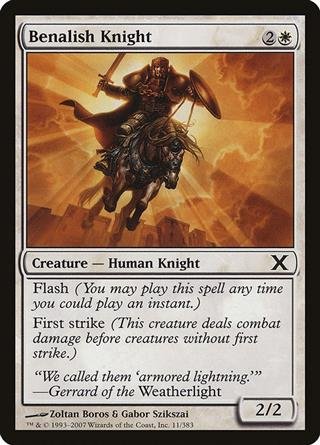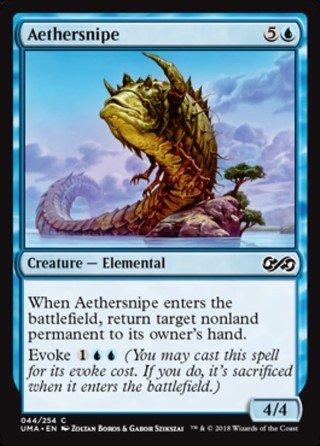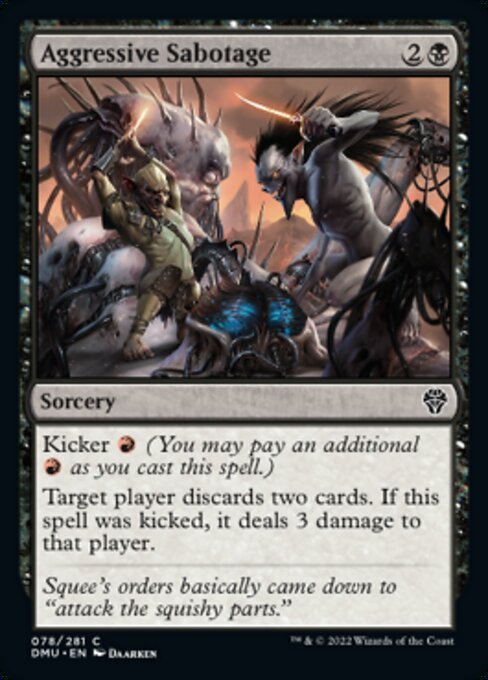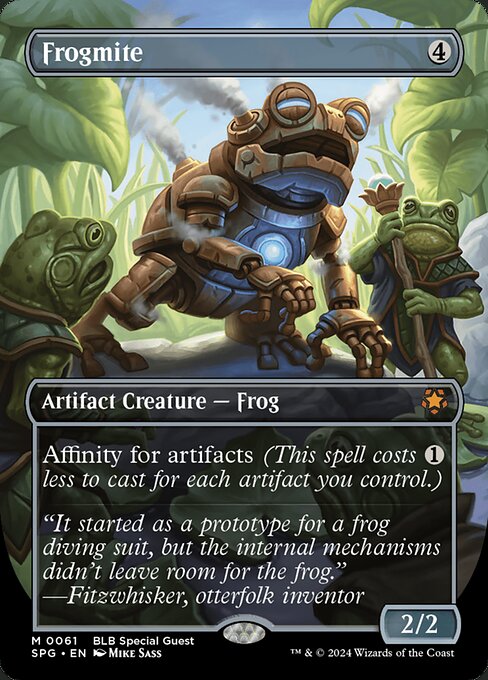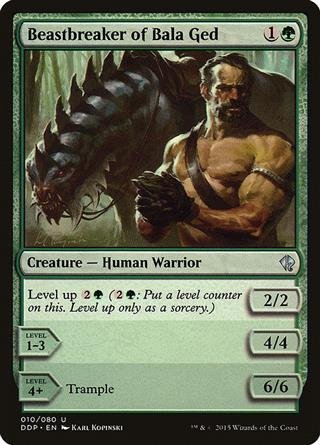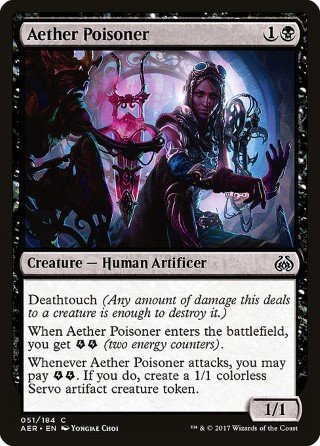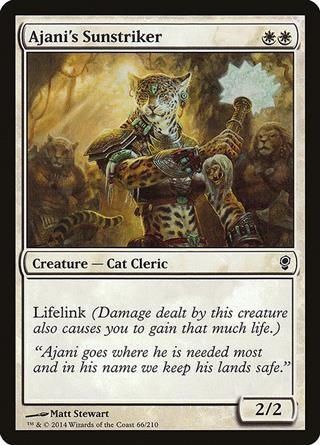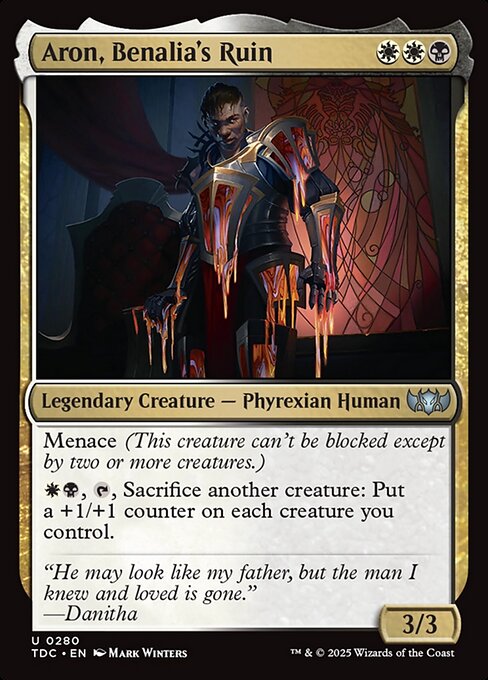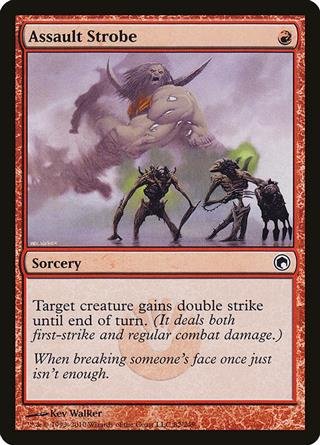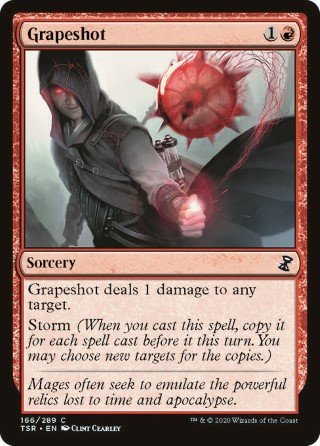How To Play Magic: The Gathering - Ultimate Guide

Magic: The Gathering (MTG) is everything you could want from a collectible TCG. It's got strategic gameplay, is complex yet easy to learn, and offers nearly endless deck-building and playstyle possibilities. It's got lore to back the cards up, RPG elements, collectability, and the best art of any TCG, bar none. Plus, you can play MTG in a multitude of unique formats, both online and in person.
Today, I will teach you how to play Magic: The Gathering (MTG) from start to finish. I'll cover everything from how the game works and the basic rules to the parts of a turn and different card types. Even if you've never picked up a deck before today, by the end of this article, you'll know how to play MTG. So, without further ado, let's get started.
How To Play Magic: The Gathering
Let's start with a fundamental overview of MTG and how it works. Each player usually starts a game of magic with a 60-card deck consisting of spells (playable cards that affect the game) and lands, which are used to "pay" for your spells. Each player will draw seven cards, determine who goes first (via die roll, coin flip, etc.), and alternate turns from there.
During a turn, a player draws one card and can play cards from their hand onto the board. Creature cards are used to attack opponents or block incoming attacks from opposing creatures. Non-creature spells can affect the game in various ways. By attacking each other or dealing damage with non-creature spells, players aim to get their opponent's life from 20 to 0 to win the game.
General Concepts
There are five colors in MTG - White, Blue, Black, Red, and Green. There are also some colorless cards, but for now, let's focus on the five colors. Each color has corresponding lands that produce that given color of "mana," which is the game's resource for playing your cards.
Every non-land card has a "casting cost," which is visible in the top right corner. You must be able to meet the mana amount and any color requirements to play a given card. For example, Lightning Bolt has one red "pip" in the in the top right corner. So, you need one mana to cast it, and it has to be red. Grizzly Bears
has one red "pip" in the in the top right corner. So, you need one mana to cast it, and it has to be red. Grizzly Bears , on the other hand, costs two mana in total. However, one can be any color, and the other must be green.
, on the other hand, costs two mana in total. However, one can be any color, and the other must be green.
Some cards also require multiple colors of mana to cast. Vindicate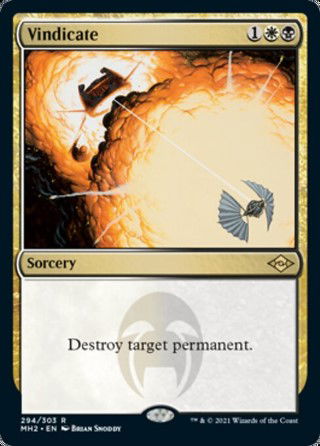 , for example, requires one mana of any color, one white mana, and one black mana. If you want to play a deck with more than one color, you'll need some land capable of producing each color you play. In this case, Plains
, for example, requires one mana of any color, one white mana, and one black mana. If you want to play a deck with more than one color, you'll need some land capable of producing each color you play. In this case, Plains (white) and Swamp
(white) and Swamp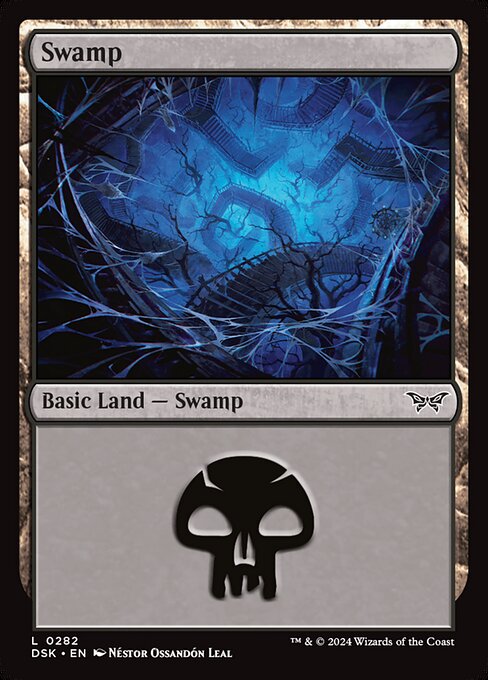 (black).
(black).
Playing Lands And Making Mana
As mentioned, mana is produced by land cards. Each of MTG's five colors has its own basic land that produces that color of mana. They are: Plains (white), Island
(white), Island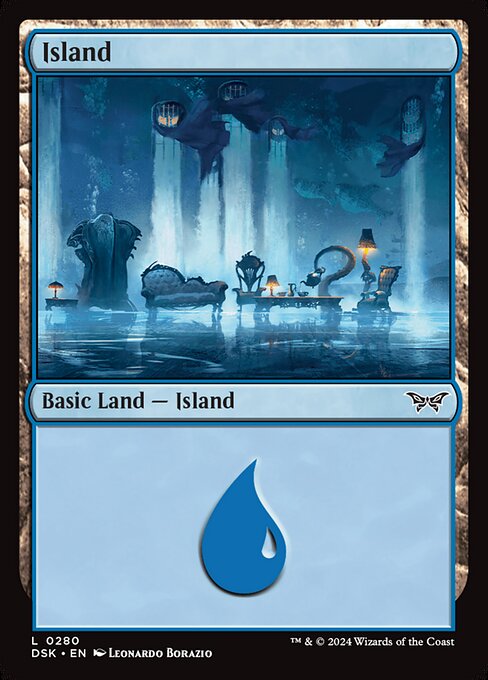 (blue), Swamp
(blue), Swamp (black), Mountain
(black), Mountain (Red), and Forest
(Red), and Forest (green). Your deck can have any number of these basic lands, and you may play one land on each of your turns.
(green). Your deck can have any number of these basic lands, and you may play one land on each of your turns.
Using a basic land produces one mana of the given color and requires you to "tap" it for the mana. Tapping is a cost of activation and simply means turning it 90 degrees to the right to show that it's been used for the turn. Once a land is "tapped," it can't be used again until it untaps at the start of your next turn.
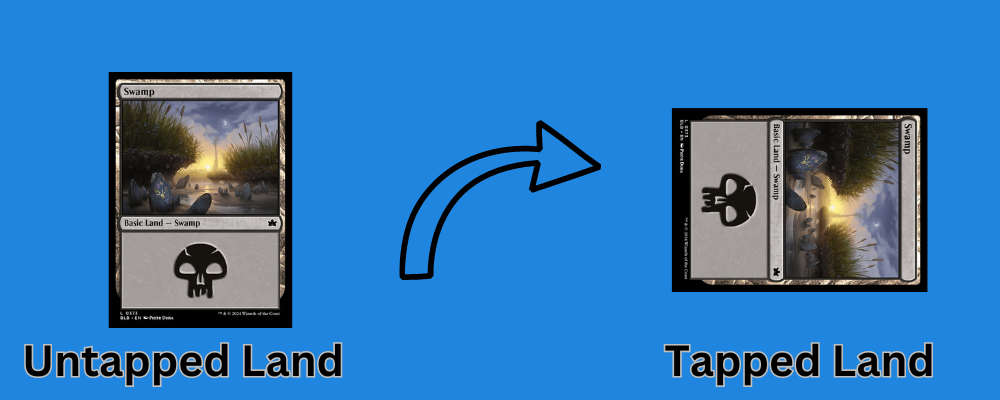
In general, this system allows you to hopefully play more and more lands as the game continues and play more high-cost cards. For example, playing one land per turn means you could cast a five-mana spell on turn five. Or, a three-mana spell and a two-mana spell. You can use your mana however you choose as long as you meet the casting cost requirements for each card. This mana system is a core element that makes MTG what it is.
It's the resource that allows you to play your cards. Each color also has unique strengths, weaknesses, and playstyles. This adds depth and complexity to deck building, as you'll have to consider which colors to include in your deck and play around with getting the number of lands you include right.
As mentioned above, if you wanted to play the card Aeromunculus , for example, you'd need to include islands and forests in your deck to give you a good chance of having access to both colors throughout the game. Here is where lands that produce multiple colors like Simic Guildgate
, for example, you'd need to include islands and forests in your deck to give you a good chance of having access to both colors throughout the game. Here is where lands that produce multiple colors like Simic Guildgate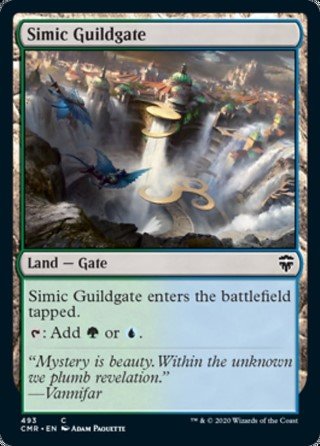 and Temple of Mystery
and Temple of Mystery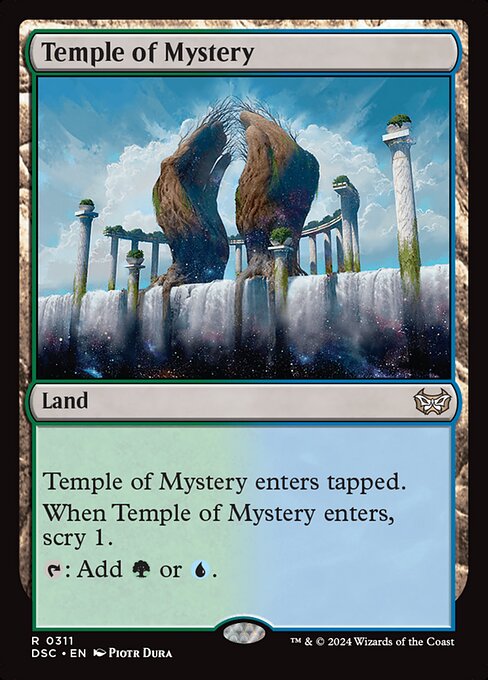 come in handy.
come in handy.
"The Board"
With that out of the way, we're ready to cast some spells... But what happens then? Well, there are a few different types of MTG cards, which I'll go over below. For now, just know each card falls into one of two categories: Cards that stay on the board and one-time effects that go away after use.
Cards that stick around are known as permanents. And they stick around until something causes them to be removed. Here is an example of what a typical MTG play area looks like and where you put your permanents as you play them.
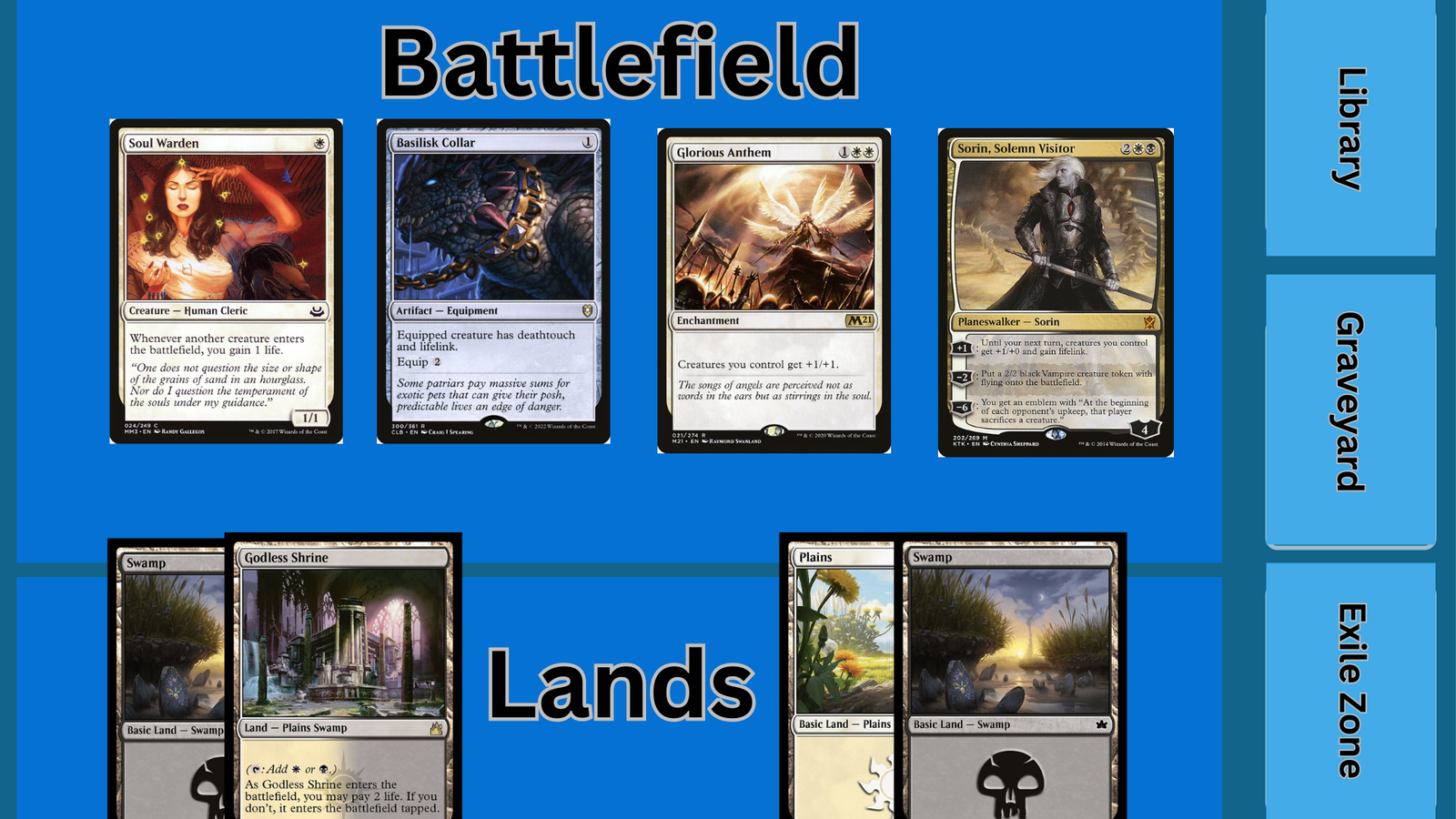
All your permanents, like creatures, artifacts, enchantments, and Planeswalkers, are placed in the upper portion of the play area labeled "battlefield" above. They don't have to be placed in any particular order as long as they're clear to everyone.
Below your creatures is where you'll put your lands. Again, no particular order is needed as long as you and your opponent can tell how many lands each player has. Off to the right of these areas, you'll place your "library" or deck, your graveyard pile for destroyed creatures or used cards, and any cards that have been exiled from your field or graveyard, as shown above.
MTG Card Types
MTG has quite a few different types of cards. We've mentioned lands and briefly mentioned other permanents like artifacts, enchantments, and Planeswalkers. Now, let's go over them in more detail and talk about the non-permanent cards as well.
Lands
Again, lands are a crucial component of your deck. They provide mana, the resource used to cast spells. Here's a breakdown of the basic land types:
- Plains: Produces white mana.
- Island: Produces blue mana.
- Swamp: Produces black mana.
- Forest: Produces green mana.
- Mountain: Produces red mana.
Beyond the basic lands, there are also many other types of lands. Some are "dual lands" that tap for two colors or mana, such as Orzhov Guild Gate. There are also lands that do things in addition to tapping for mana. For example, Hall of Heliod's Generosity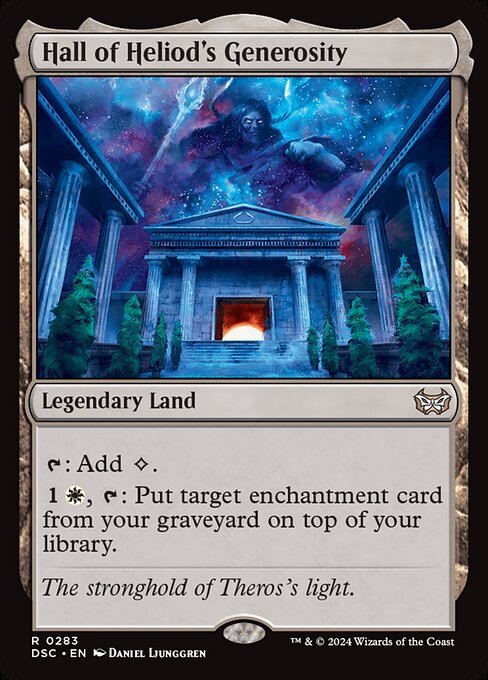 can tap for colorless mana, and has an ability as well.
can tap for colorless mana, and has an ability as well.
Now, let's look at some card anatomy for lands:
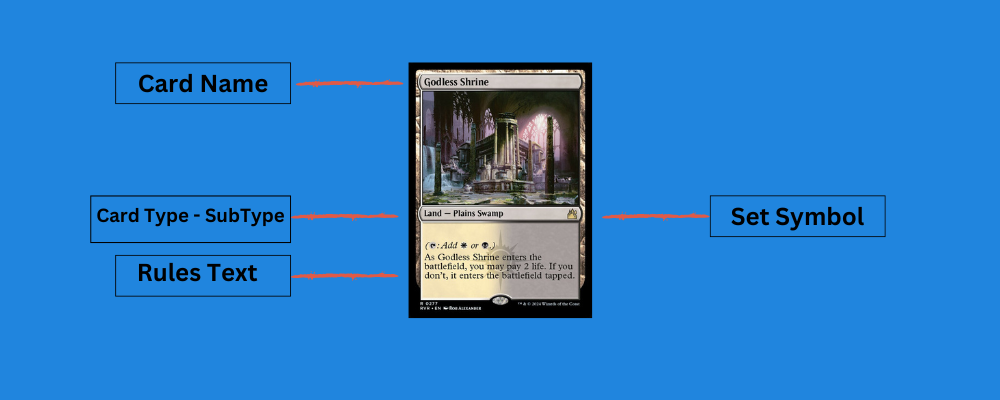
At the top of each card, you'll find the card name. After the art box, you'll find the card type, followed by the subtype(s). In this particular example, the card type is "land" and the subtype(s) are plains and swamp. These subtypes are important to note: Anything that references a "swamp" Defile or a "plains" Staff of the Sun Magus
or a "plains" Staff of the Sun Magus the Godless Shrine will count toward.
the Godless Shrine will count toward.
Across from the type and subtype, you'll find a symbol that indicates which set the card comes from. You may notice these symbols in a few different colors, which indicates rarity and has no meaning in gameplay. Below these lines is the rules text, where you'll find an explanation of what the card does and any abilities it has.

The symbol above (the one on the left is an old version; the right is modern) is a "tap" symbol, which means the card must be tapped to activate and turned sideways to show it's tapped. So, in our example of Godless Shrine , the rules text states, "Tap: Add one white mana or black mana." It is followed by, " As Godless Shrine enters, you may pay 2 life. If you don’t, it enters tapped."
, the rules text states, "Tap: Add one white mana or black mana." It is followed by, " As Godless Shrine enters, you may pay 2 life. If you don’t, it enters tapped."
MTG is designed in a way that (most times but not always) simply reading a card will tell you what it does.
Creatures
Creatures are your primary attackers and defenders. Creatures can not attack (or tap to activate abilities) the turn they enter the battlefield unless they have haste. Each creature has a power (damage dealt) and toughness (damage it can take before dying) attribute. Example: Grizzly Bears is a 2/2 creature (2 power, 2 toughness). Creatures also have types and subtypes. Here is a breakdown of what you can expect to see on creatures in MTG:
is a 2/2 creature (2 power, 2 toughness). Creatures also have types and subtypes. Here is a breakdown of what you can expect to see on creatures in MTG:
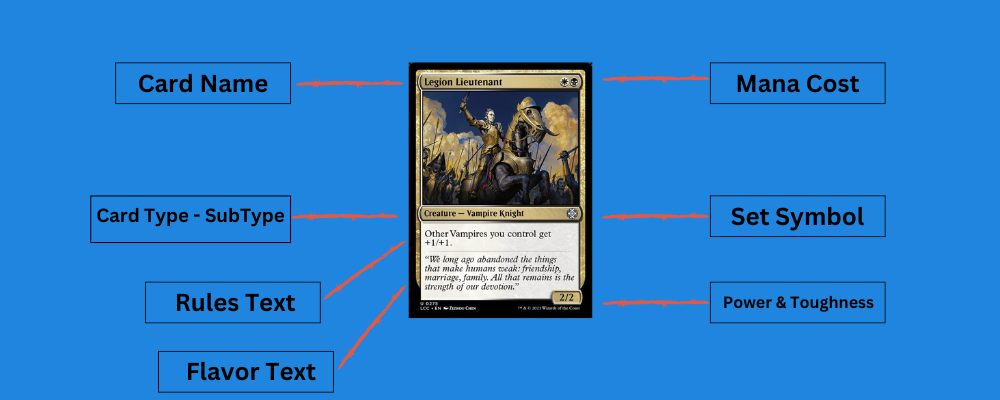
On creatures, we find many of the same fields found on the land pictured above. The card name, card type, subtype, rules text, and set symbol are located in the same spot and serve the same purpose. However, unlike lands (which aren't cast), creatures have a mana cost, which is found in the top right corner.
As mentioned in the "using lands" section, you must have adequate lands in play to produce the overall amount of mana (in this case, two) and any color requirements (one black, one white) to cast the given creature. In the bottom right corner of a creature card, you'll find the creature's power (on the left) and toughness (on the right.)
The power is how much damage the creature deals when it attacks. If the creature is not blocked, it deals this damage to the opponent. If it is blocked, it deals this damage to the creature(s) that blocked it. The toughness is how much damage the creature can receive before it is destroyed. In this example, both are two.
Just like with the land, the subtypes are relevant to certain cards:

In this example, Legion Lieutenant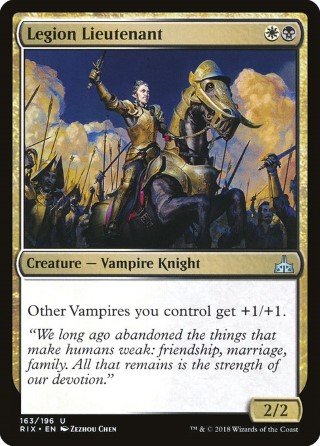 is a creature, a vampire, and a knight. So, cards that mention creatures, like Murder
is a creature, a vampire, and a knight. So, cards that mention creatures, like Murder , are relevant. So, too, anything that pertains to vampires (Duskborne Skymarcher
, are relevant. So, too, anything that pertains to vampires (Duskborne Skymarcher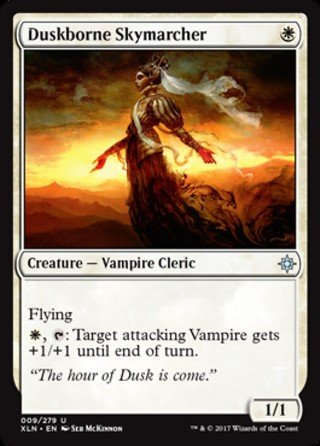 ) or knights (Garrison Griffin
) or knights (Garrison Griffin ).
).

A mention of the vampire creature type can also be found in Legion Lieutenant 's rules text, which grants a +1/+1 boost to the power and toughness of other vampires you have in play. So, if you had a Barony Vampire
's rules text, which grants a +1/+1 boost to the power and toughness of other vampires you have in play. So, if you had a Barony Vampire , a vampire, in play alongside the Lieutenant here, it would go from a 3/2 to a 4/3 thanks to this boost.
, a vampire, in play alongside the Lieutenant here, it would go from a 3/2 to a 4/3 thanks to this boost.
"Flavor text" is found on some cards (of all types) but isn't something you'll see on every single MTG card. The flavor text does not have anything to do with gameplay. Its purpose is to add narrative context and lore to the card's mechanics or theme. Flavor text is always italicized, too, which makes it easier to distinguish from other parts of the card.

Instants
Instants can be played anytime you have the mana to cast them, even during your opponent's turn. This makes them very versatile, allowing for quick responses to opponents' actions or to disrupt their plans. If a card is an instant, it will say so in the "card type" box:
![]()
Let's look at an example of what makes instant speed cards good. Giant Growth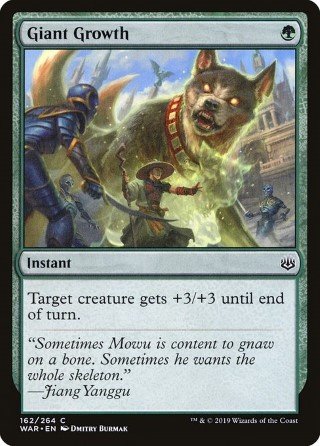 is an instant that gives a creature +3/+3 until the end of the turn. Let's say you have a Goblin Assailant
is an instant that gives a creature +3/+3 until the end of the turn. Let's say you have a Goblin Assailant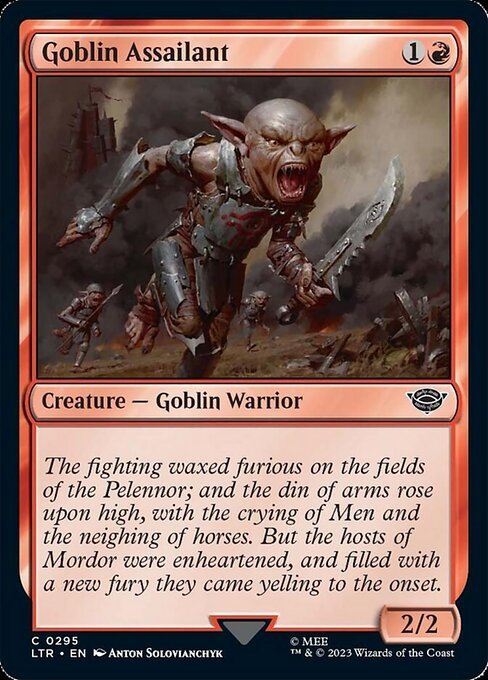 in play, and it's your opponent's turn. They would rather you not have your goblin.
in play, and it's your opponent's turn. They would rather you not have your goblin.
So, that tap two mana and cast Defeat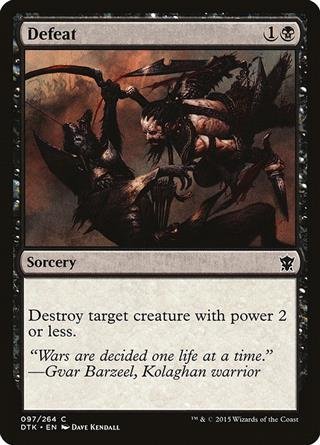 . Considering your goblin does have power 2 or less, it should be all but dead. Ah, but you've got that Giant Growth
. Considering your goblin does have power 2 or less, it should be all but dead. Ah, but you've got that Giant Growth we mentioned above, and it's an instant.
we mentioned above, and it's an instant.
So, you can say, "Not so fast, I'm going to tap my untapped Forest and play Giant Growth
and play Giant Growth ." Thanks to being an instant, you can do this even though it's their turn. Now, once you play your Giant Growth (and target your goblin), it will get the +3/+3 boost, becoming a 5/5 until the end of the turn, and no longer die to Defeat
." Thanks to being an instant, you can do this even though it's their turn. Now, once you play your Giant Growth (and target your goblin), it will get the +3/+3 boost, becoming a 5/5 until the end of the turn, and no longer die to Defeat because its power is now over two.
because its power is now over two.
It's important to remember that you have to have the available mana to pay for your spell, just like you would if you'd cast it on your turn. And instants are not permanents like lands or creatures. So, once you've used them, they'll be placed in your graveyard.
Sorceries
Sorceries are one-time-use spells that can only be cast during the main phases of your turn. Like instants, they aren't permanent, so they don't go onto the battlefield. Instead, you cast them, their effect happens, and they're placed in your graveyard. For example, if you tap three lands and cast Divination , you'll draw two cards and place Divination into your graveyard.
, you'll draw two cards and place Divination into your graveyard.
Enchantments
Enchantments provide ongoing effects that last as long as they remain on the battlefield. This is easy to remember by thinking of them "enchanting" the battlefield or a creature. Some enchantments like Rest in Peace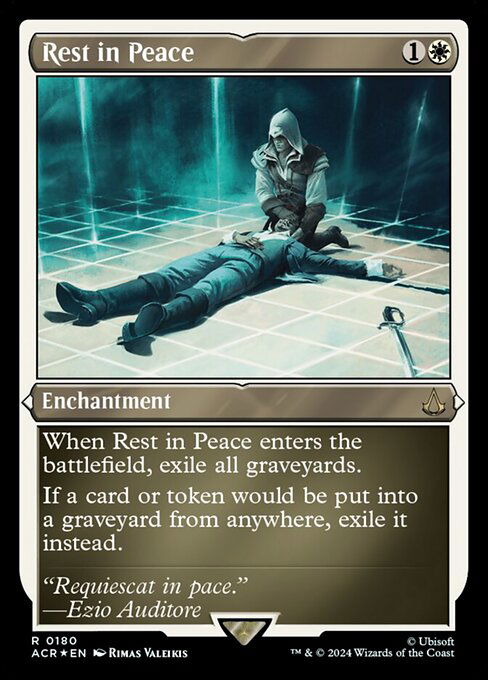 and Bad Moon
and Bad Moon affect both sides of the battlefield. In contrast, something like Glorious Anthem
affect both sides of the battlefield. In contrast, something like Glorious Anthem specifies that your creatures get +1/+1.
specifies that your creatures get +1/+1.
Other enchantments that have the subtype "aura" enchant a single permanent instead of the battlefield as a whole. Rancor , for example, gives a creature extra power and trample. While Abundant Growth
, for example, gives a creature extra power and trample. While Abundant Growth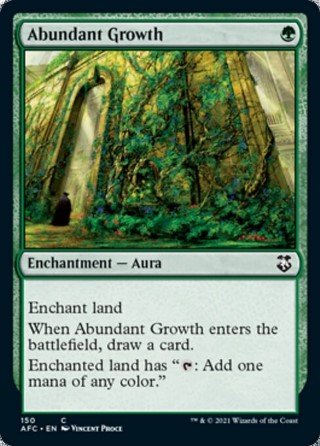 enchants a land and makes it produce extra mana. If you put an aura on something and the "something" gets destroyed, the aura is also destroyed.
enchants a land and makes it produce extra mana. If you put an aura on something and the "something" gets destroyed, the aura is also destroyed.
There are also enchantment creatures. These cards have the card type enchantment and creature and are treated as both. So, anything referring to either permanent type would apply. For example, a Brain Maggot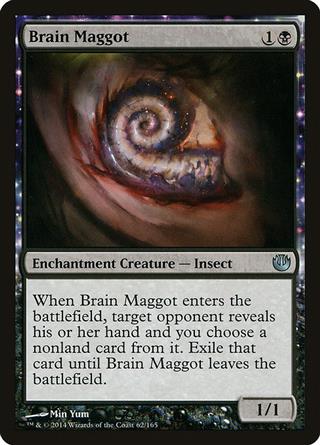 could be destroyed by something that removes enchantments like Disenchant
could be destroyed by something that removes enchantments like Disenchant and/or creature removal like Murder
and/or creature removal like Murder .
.
Artifacts
Artifacts are versatile cards that can do various things, including some that tap to produce mana. Artifacts are usually (but not always) colorless, meaning they can go into any deck, but they typically have a worse mana cost to power level ratio to offset the upside of being colorless. Like enchantments, they are permanents and stay on the field until something removes them.
Also, like enchantments, some artifacts affect the game as a whole, like (Angel's Feather ); others, called "equipment," can be attached to creatures (Short Sword
); others, called "equipment," can be attached to creatures (Short Sword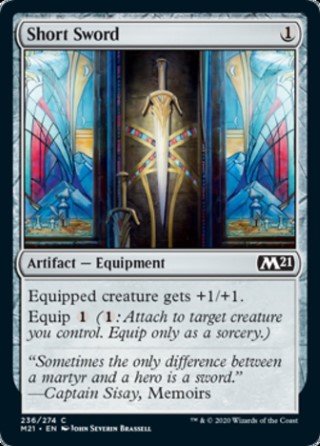 ) for a cost, and some are creatures (Steel Overseer
) for a cost, and some are creatures (Steel Overseer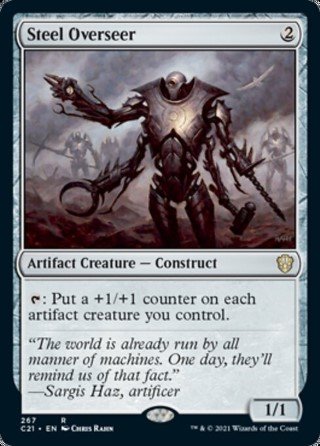 ). Unlike auras, you cast equipment for their mana cost, and then pay a seperate "equip cost" to put them onto a creature. If an equipped creature is destroyed, the equipment stays on the field and can be put onto another creature by paying the equipment cost again.
). Unlike auras, you cast equipment for their mana cost, and then pay a seperate "equip cost" to put them onto a creature. If an equipped creature is destroyed, the equipment stays on the field and can be put onto another creature by paying the equipment cost again.
Planeswalkers
Planeswalkers represent in-game allies that come with a set number of loyalty counters when you play them and have abilities you can activate once per turn. Some abilities add counters (allowing you to save up for the more costly abilities), and others reduce counters.
Let's look at Liliana, the Last Hope as an example:
as an example:

In the bottom right corner of a planeswalker card, you'll find their starting loyalty. In this case, the starting loyalty is three. Each ability on a planeswalker adds or subtracts loyalty from your total. If the loyalty counter count reaches zero, the planeswalker is defeated. When a planeswalker is attacked by a creature and isn't blocked, it loses loyalty equal to the attacking creature's power.
You can use one ability per turn, assuming you can pay for it. So, when you cast the Liliana pictured above, you start with three loyalty and could use the +1 ability, add one loyalty (going to four total), and give a creature -2/-1 until your next turn. Or you could use the -2 ability (going down to one loyatly) to mill two cards, then you return a creature card from your graveyard to your hand.
The final ability for a planeswalker is often very powerful and costs more. For our example card, the final "ultimate" ability is a -7. This means you'd have to use the +1 four times, without losing any loyalty, to build up to this. That said, you've got to use your walkers strategically. Do you want to get quick value by spending loyalty or to "plus" your walker and build toward the more costly abilities?
The Phases of a Turn

Each turn in MTG is divided into several phases, and there are certain things you may and may not do in each one. Having a good understanding of the phases of a turn will allow us to move into other concepts, such as attacking and card types that have restrictions on when they can be cast.
Here is a rundown of what you can do during your turn:
- Begin
- Untap (turn your cards upright)
- Draw a card
- Main Phase 1
- Play a land (only 1 per turn)
- Cast creatures and other spells
- Combat
- Declare attackers.
- Your opponent declares blockers
- Combat damage is dealt
- Main Phase 2
- Play a land (if you haven't already)
- Cast creatures and other spells
- End
- Creatures heal
- Pass the turn
Aside from this basic "what you can do in a turn," there are a few more technical phases to mention. I'll relist the ones mentioned above with the new ones to give you a clear picture of what they are and when they happen.
1. Untap Step
2. Upkeep Step: Some abilities trigger here. Phyrexian Arena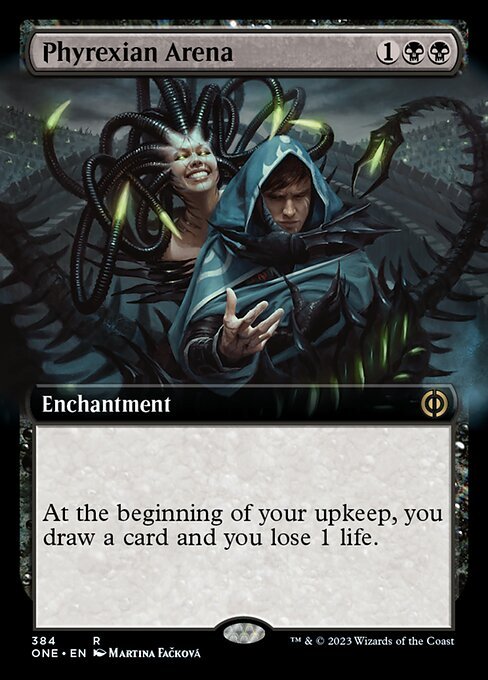
3. Draw Step
4. First Main Phase
5. Combat Phase
6. Second Main Phase
7. End Step: Certain effects or abilities may trigger. Abiding Grace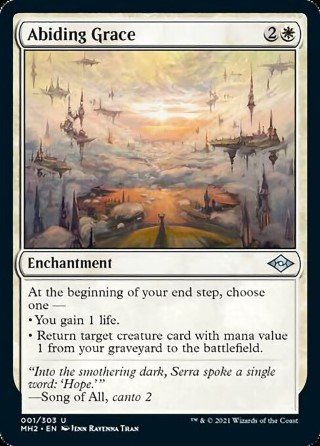
8. Cleanup Step: Discard down to seven cards in hand if you have more.
MTG Combat Explained
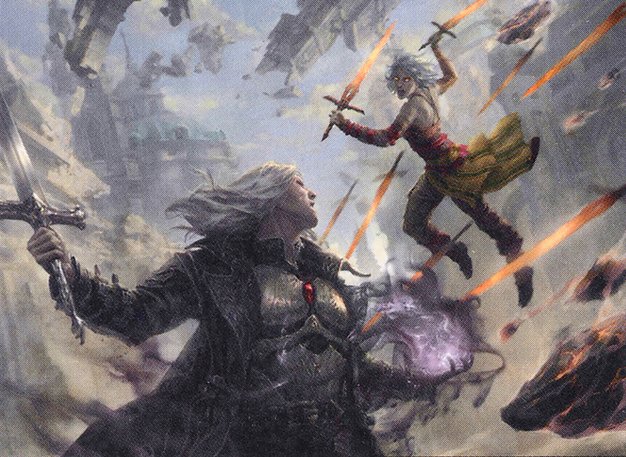
The combat phase occurs during your turn, after your first main phase, and before your second main phase. It's divided into several steps:
Beginning of Combat Step:
This is a preparatory step where players can cast spells or activate abilities before attackers are declared. No attacking or blocking happens here, but you can use this step to affect the upcoming combat (e.g., tap an opponent's creature so it can't block).
Declare Attackers Step
This is where you'll choose which of your creatures are attacking, tap them to indicate they're attacking, and specify if they're attacking your opponent or a planeswalker your opponent controls. These actions in the declare attackers step happen as follows:
- Choose Attackers: As the active player (the one whose turn it is), you choose which of your untapped creatures will attack. You can attack your opponent directly or their Planeswalkers.
- Tap Attackers: When you declare a creature as an attacker, you tap it, meaning it turns sideways to indicate it’s attacking. (Creatures with vigilance do not tap when they attack.)
- Targeting Planeswalkers: If your opponent has one or more planeswalkers, you can choose to attack one of them instead of attacking the opponent directly.
Declare Blockers Step
After you've declared your attackers, your opponent will have the option to block your attackers with any uptapped creatures they have in play. Blocking doesn't require the defending creature to tap. So, to keep track of which creature is blocking, it's common for the defending player to place their blocking creatures in front of the attacking creatures to show which is blocking which.
Multiple creatures can block a single attacker. In this case, the attacking player decides the order in which damage is dealt to the blockers.
Here is a list of these happenings and the order in which they occur:
- Opponent Chooses Blockers: Your opponent decides which of their untapped creatures will block your attacking creatures. Each blocking creature can only block one attacker unless it has a special ability like "block any number of creatures."
- Blocker Assignment: The opponent places their blocking creatures in front of the attacking creatures to show which is blocking which.
- Double Blocking: Multiple creatures can block a single attacker. In this case, the attacking player decides the order in which damage is dealt to the blockers.
Combat Damage Step
Here is where the attacking and blocking creatures from the previous steps will actually deal damage to one another, and the player being attacked will receive any damage from creatures that weren't blocked. Creatures (regardless of attacking or blocking) are dealt damage simultaneously. Any creature (regardless of attacking or blocking) who is dealt damage equal to or greater than its toughness is destroyed and placed in its owner’s graveyard.
- Damage Assignment: Combat damage is assigned and then dealt simultaneously by both attacking and blocking creatures.
- Blocked Creatures: If a creature is blocked, it deals damage to the blocker(s).
Unblocked Creatures: If a creature is not blocked, it deals damage directly to the opponent or planeswalker it attacked. - Damage Effects: After damage is dealt, if a creature’s toughness is reduced to 0 or less due to combat damage, it is destroyed and placed in its owner’s graveyard.
End of Combat Step:
This step allows players to cast spells or activate abilities after combat damage has been dealt with but before the combat phase ends.
Understanding the Stack
The "stack" helps determine the order in which spells and abilities are resolved. This is a sort of imaginary limbo in which a spell is in between being cast and entering the battlefield or taking effect. When a spell is cast, it goes "on the stack," and players have a chance to respond (before the spell being cast resolves) with instants or activated abilities.
The stack resolves in a "last-in, first-out" order. So, the last spell or ability placed on the stack resolves first. In other words, you can imagine a spell being cast as being put on a table. Each subsequent spell is "stacked" on top. Then, when both players finish adding spells, the card that would be on top of "the stack" (i.e., the last card added) would resolve first, and resolution would continue from there.
Here is an example:
You cast Lightning Bolt targeting your opponent. It goes on the stack. Your opponent responds by casting Counterspell
targeting your opponent. It goes on the stack. Your opponent responds by casting Counterspell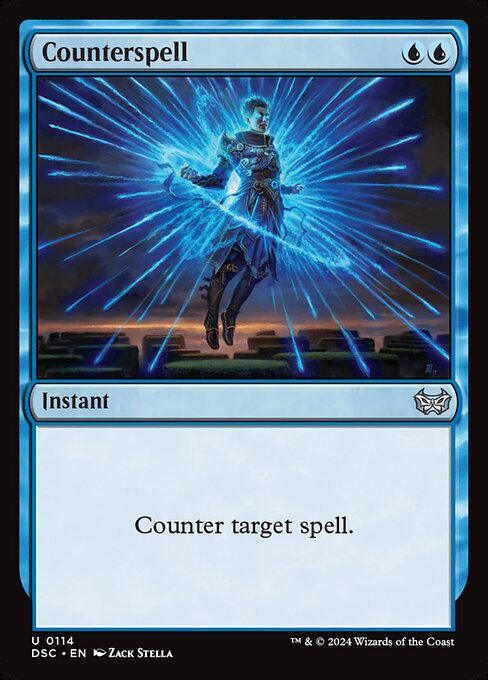 targeting your Lightning Bolt. With Counterspell on the stack, you respond by casting Negate
targeting your Lightning Bolt. With Counterspell on the stack, you respond by casting Negate targeting your opponent's Counterspell. Now, the stack looks like this:
targeting your opponent's Counterspell. Now, the stack looks like this:
3. Negate
2. Counterspell
1. Lightning Bolt
Since the top card on the stack is Negate, it resolves first. Negate counters the Counterspell, so it goes to the graveyard. Then, Lightning Bolt resolves, and it deals damage to your opponent.
The Color Pie And Playstyles

Each of the five colors of MTG has its strengths, weaknesses, and playstyles. They also have a specific worldview or flavor that corresponds with how they play and what they can and can't do. Here is a very general overview:
- White (Plains): Focuses on order, protection, justice (like exiling opposing creatures)
- Blue (Island): Specializes in control, card draw, and manipulating the game (like countering spells).
- Black (Swamp): Deals with death, decay, and sacrificing resources for power (like forcing your opponent to discard cards).
- Red (Mountain): Emphasizes speed, direct damage, and chaos (like dealing damage to any target).
- Green (Forest): Represents growth, nature, and big creatures (like ramping up mana production).
For a deep dive on color pie (which I recommend you check out), you can go here: Color In MTG
Advanced Card Types And Keywords
- Flying: This creature can only be blocked by other creatures with flying. (Aesthir Glider
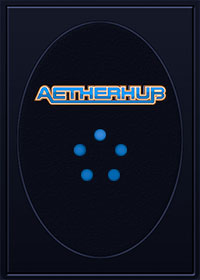 )
) - First Strike: Damage from this creature is dealt first in combat. (Anaba Bodyguard
 )
) - Haste: This creature can attack the turn it enters the battlefield. (Akoum Battlesinger
 )
) - Trample: Excess damage from this creature goes to the player. (Aggressive Mammoth
 )
) - Vigilance: This creature can attack and block on the same turn it enters the battlefield. (Alpine Watchdog
 )
) - Flash: You can cast this spell at instant speed. (Benalish Knight
 )
) - Evoke: You can pay an additional cost to return this creature to your hand. (Aethersnipe
 )
) - Morph: This creature starts face down and can be turned face up for an additional cost. (Ainok Tracker
 )
) - Kicker: You can pay an additional cost to get an extra effect. (Aggressive Sabotage
 )
) - Flashback: You can cast this spell from your graveyard for an additional cost. (Lingering Souls
 )
) - Suspend: This spell is exiled for a number of turns, then enters the battlefield. (Ancestral Vision
 )
) - Affinity for a color or type: This creature's cost is reduced based on the number of permanents of that color or type you control. (Frogmite
 , Oxidda Golem
, Oxidda Golem )
) - Level Up: This creature gains abilities and stats as you pay its level-up cost. (Beastbreaker of Bala Ged
 )
) - Deathtouch: Any amount of damage this deals to a creature is lethal. (Aether Poisoner
 )
) - Lifelink: Whenever this creature deals damage, you gain that much life. (Ajani's Sunstriker
 )
) - Menace: This creature can't be blocked except by two or more creatures. (Aron, Benalia's Ruin
 )
) - Double Strike: This creature deals both first strike and regular combat damage. (Assault Strobe
 )
) - Storm: You may cast additional copies of this spell for each spell cast before it this turn. (Grapeshot
 )
)
Basic Deck-Building Strategies
Deck building in Magic: The Gathering is an art, and many things go into building a good deck. The main concepts you should be aware of are having enough lands in your deck and how much mana the cards in your deck cost. How many lands you need will depend on your strategy, but usually, between 20 and 24 is normal for most formats (except for draft and EDH).
The more mana your spells cost, the more lands you'll probably need. In most cases, you want some lower to mana-value cards (to ensure you have things to play early) and some higher mana-value cards so you'll have more powerful stuff as the game goes on. However, having the majority of your cards somewhere in the middle will help make the strategy consistent and make sure you're able to cast things all throughout the game. This concept is called your "mana curve."
Here are some very basic guidelines for building an MTG deck from scratch:
1. Define Your Strategy
- Identify Your Win Condition/Play Style: Will you overwhelm opponents with creatures, control the board with removal and countermagic, or drain their life totals?
- Choose Your Colors: Select colors that synergize with your chosen strategy. For example, red and green are often used for aggressive strategies, while blue and black are better suited for control.
2. Start Building Your Decklist
- Card Selection: Choose cards that align with your strategy. Prioritize efficient mana curves, powerful threats, and effective removal spells. You can search for cards by keywords or type here.
- Mana Base: Ensure a smooth mana curve by including the right number and type of lands.
3. Playtesting and Refinement
- Test Your Deck: Playtest your deck against various opponents and strategies to identify its strengths and weaknesses.
- Analyze Your Losses: Determine why you lost games and make adjustments to your decklist accordingly.
- Iterate and Improve: Continuously refine your deck by adding or removing cards based on your playtesting experiences. Remember, no deck is perfect. Every deck has favorable and unfavorable matchups.
Formats
One of the best things about MTG compared to other TCGs is the different ways you can play Magic. For an in-depth explanation of these formats, check out my article All MTG Formats Explained. For now, here is a small rundown of the most common/established formats:
- Limited (Draft/Sealed): In these formats, players open a set number of booster packs and construct decks from the cards they open.
- Standard: This format uses the most recent sets of cards, providing a constantly evolving and dynamic playing experience.
- Modern: This format uses cards from the 8th Edition set forward, offering a wider card pool and more strategic depth.
- Commander (EDH): A multiplayer format focused on building powerful, themed decks around a legendary creature commander.
Beyond these, there are numerous other formats, both official and unofficial, including:
- Legacy: Uses cards from all sets, with the exception of special expansions and sets.
- Vintage: The oldest format, allowing for virtually any Magic card ever printed.
- Pauper: A budget format where players can only use common cards.
- Pioneer: A format using cards from the Return to Ravnica block forward.
- Historic: A digital-only format using cards from Arena and MTG Arena sets.
Additionally, there are numerous casual and custom formats played by Magic enthusiasts worldwide, further expanding the possibilities of the game. Perhaps the most user friendly way to learn the game for new players is MTG Arena, which is an online platform with a user-friendly tutoria. Check out my guide here: How To Play MTG Arena - A Guide For New Players if you're interested.
The best way to master MTG is through experience. Play with different decks, participate in events, and learn from each game. Watching experienced players or playing online can also accelerate your understanding.


